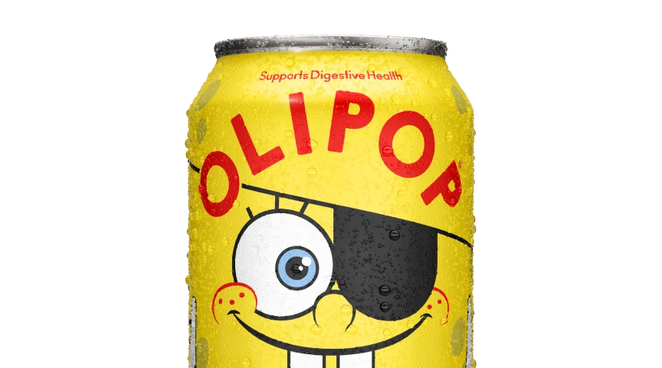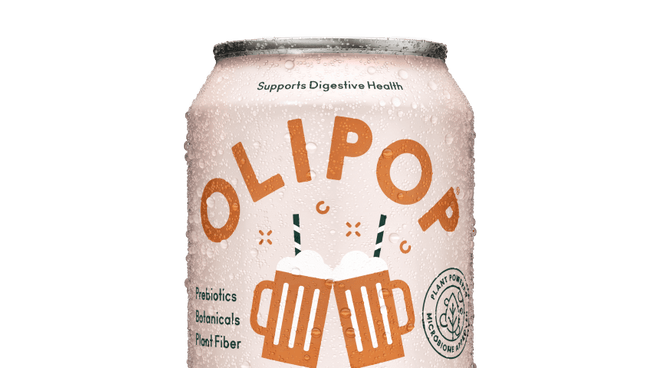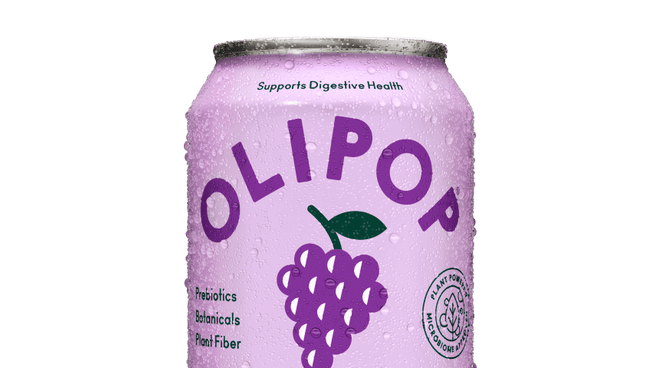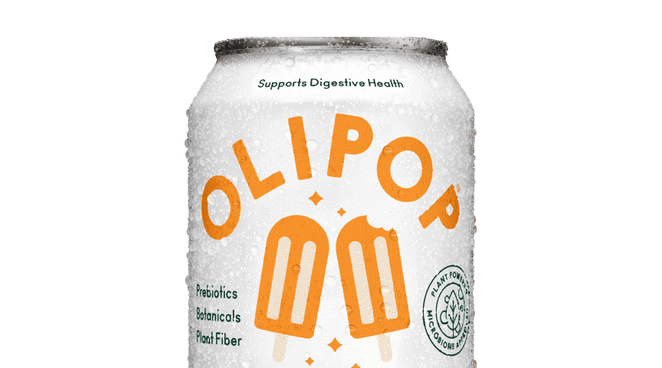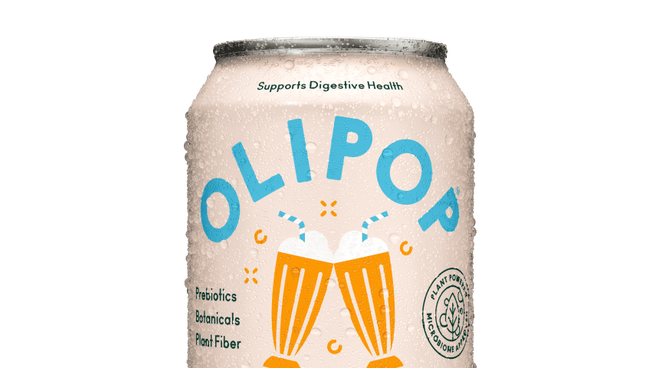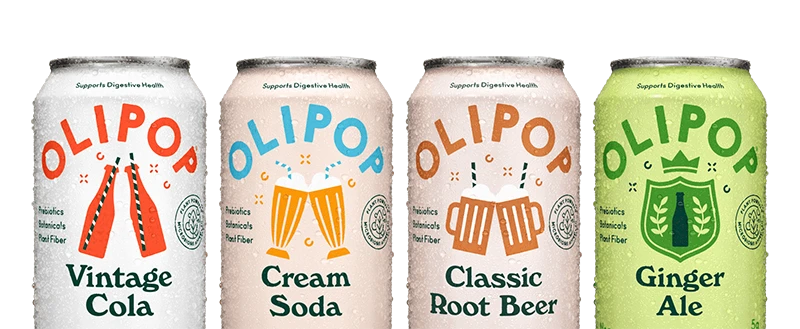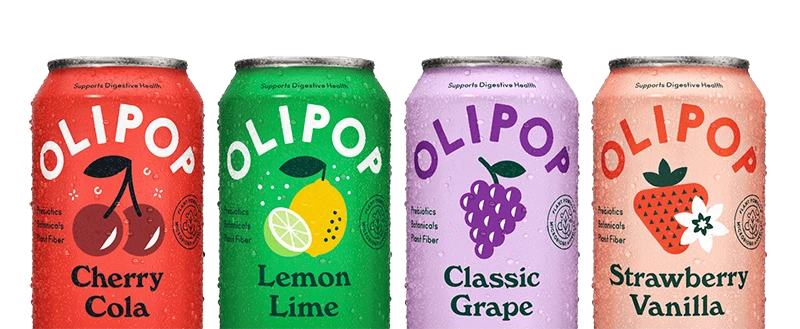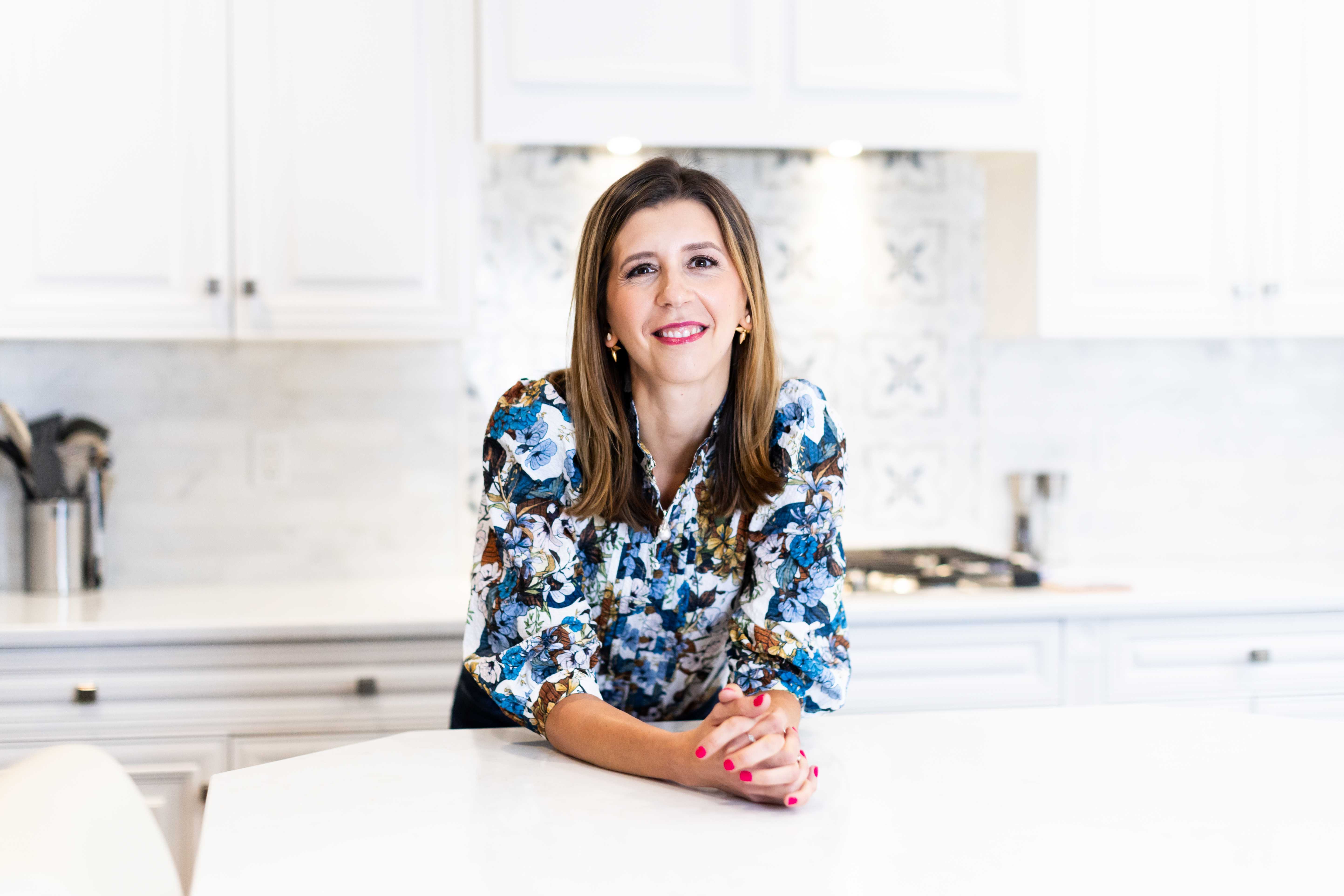Gut bacteria thrive when they have food in the form of fiber. Most of the bacteria in your microbiome happen to be foodies—and they're very particular about what they eat. Their favorite food? Fiber.
Here’s everything you need to know about fiber and why it’s a primo ingredient in OLIPOP so you can increase your intake and support your digestive health.
What Is Fiber?
Fiber, sometimes called roughage or bulk, is the non-digestible portion of plants that our digestive system can’t completely break down, but plays a crucial role in supporting overall health and digestion.[1] Unlike fats, proteins, and carbohydrates, which your body breaks down and absorbs, humans don't have the digestive enzymes to break down fiber. However, the bacteria in our gut do! The intestinal microbiome uses fiber from our diet to create energy and produce beneficial metabolites.[2]
Types of Fiber
Fiber is typically categorized into two types: soluble and insoluble.[1] Let’s dig into these:
Soluble Fiber
Soluble fibers are found in foods such as oats, nuts, seeds, beans, lentils, barley, and some fruits and vegetables, such as apples and onions. They dissolve in water, forming a gel-like substance that can help slow digestion, thereby slowing sugar absorption and supporting healthy cholesterol levels over time.[2] If you've ever seen or eaten chia seeds and noticed the gel that forms around them, then you've seen soluble fiber in action! Some soluble fibers are also prebiotic and serve as food for the good bacteria that naturally reside in your gut.[3]
Here are some common types of soluble fiber:
- Inulin: Inulin is a type of soluble fiber that belongs to a class of carbohydrates known as fructans. It's most commonly found in chicory root, asparagus, bananas, garlic, leeks, and onions.[4]
- Acacia fiber: This soluble fiber comes from the dried, powdered tree sap of the Acacia tree species. It’s generally well tolerated and may increase satiety and may help support a healthy blood glucose response in healthy individuals.[5] This soluble fiber is found in our shelf-stable OLIPOP formula!
- Guar fiber: This soluble, prebiotic dietary fiber comes from the endosperm of the guar bean. It’s a well-studied fiber with digestive health benefits for improving microbiome composition and aiding in occasional constipation in healthy individuals.[6][7] This soluble fiber is found in our shelf-stable OLIPOP formula!
- Pectins: These are derived from plant cell walls and are often found in fruits and legumes such as beans and lentils. Pectins help to thicken foods, which is why they’re often found on the ingredient list of jellies and jams.[8]
- Psyllium: This soluble fiber absorbs water in the intestines to help add bulk to your stool. This type of polysaccharide is derived from Plantago ovata seeds and is often added as a powder to food or drinks.[9]
- Fructooligosaccharides (FOS): Short fructose chains are often used as an alternative to sugar due to their prebiotic effects and beneficial mineral absorption. You can find FOS in fruits, vegetables, and grains such as onion, chicory, garlic, asparagus, banana, and artichoke.[10]
- Resistant Starch: A type of starch that resists digestion in the small intestine. This then allows it to reach the colon, where it’s fermented by gut bacteria as a soluble fiber. Legumes, unripe bananas, and certain cooked and cooled starchy foods contain resistant starch. In OLIPOP, we use resistant starch extracted from the root of cassava.
- Beta-glucans: These are sugar compounds that serve as the primary form of fiber found in the cell walls of cereals, grains, and fungi. Think mushrooms! You'll find beta-glucans in bacteria, yeast, fungi, algae, and plants such as oats and barley.[11]
Insoluble Fiber
Insoluble fibers are found in foods such as whole wheat or whole grain products, wheat bran, and vegetables. They do not dissolve in water. Instead, they help move food through the digestive tract and add bulk to stool, helping to promote regular bowel movements. Essentially, this fiber acts as bulk to keep your digestive system running smoothly.[12]
Here are some common types of insoluble fiber: [3]
- Cellulose: This is the most abundant form of insoluble fiber, and you'll find it in the cell walls of plants. Foods with cellulose include whole grains, bran, vegetables (especially those with a fibrous structure, like celery), and fruits with skins (such as apples).
- Hemicellulose: Another component of plant cell walls, and is a complex branched polymer. Foods with hemicellulose include whole grains, bran, nuts, and seeds.
- Lignin: This is a complex, non-carbohydrate substance also found in the cell walls of plants to help with rigidity. (Noticing a pattern here with plant cell walls?) Bran layers of whole grains, seeds, and the skins of certain fruits like berries contain lignin.
- Chitin: This is a polysaccharide found in the exoskeletons of insects and crustaceans and the cell walls of fungi. You're less likely to come across this insoluble fiber in your everyday diet, but you may find it in some dietary supplements.
Prebiotic Soluble Fibers in OLIPOP
No matter what type of OLIPOP you're drinking (shelf-stable or refrigerated), you are getting 6 to 9 grams of fiber per serving, which meets the FDA's criteria for an excellent source of fiber. Our flavors feature a blend of soluble, prebiotic fibers, including:
Acacia Fiber
Acacia fiber is a soluble, non-viscous fiber made from the dried, powdered tree sap of the Acacia tree. Acacia fiber is generally well tolerated and may increase satiety and may help support a healthy blood glucose response in healthy individuals.[5]
Guar Fiber
Guar fiber is a soluble, prebiotic dietary fiber obtained from the endosperm of the guar bean (Cyanopsis tetragonolopus). It’s a well-studied fiber that shows digestive health benefits for improving microbiome composition and aiding in occasional constipation in healthy individuals. [6][7][13][14]
Inulin
Inulin is a soluble, prebiotic fiber naturally occurring in plants such as chicory root, Jerusalem artichoke, onion, and barley. Inulin is widely used across the food industry to help add fiber to various formulations. Inulin has also been well studied and recognized as a fiber with an outstanding effect on intestinal microbiota regulation by stimulating the growth of beneficial bacteria.[14]
Resistant Dextrins
OLIPOP also contains resistant dextrins derived from cassava roots. This prebiotic fiber resists digestion and passes to the large intestine, where it's fermented by beneficial bacteria.[15]
Benefits of Fiber
So, we’ve learned all about fiber and the different types. But why do you need fiber? The short answer: your body needs both soluble and insoluble fiber to maintain proper digestive health. There are many health benefits of consuming adequate amounts of soluble and insoluble fiber in your diet. Research has established that fiber can:[16][17]
- Aid in satiety (the feeling of fullness after eating)
- May help support a healthy body weight
- Absorb water and slow down digestion, promoting better food and nutrient absorption
- Certain fibers have a prebiotic effect (i.e., stimulate the growth of beneficial bacteria in your gut, which promotes overall gut health)[3]
- Add bulk to stool, which can help support regular bowel movements
The Importance of a High-Fiber Diet
Healthy men and women under the age of 50 require 25 to 38 grams of fiber daily. However, most Americans fall short of meeting these requirements. More than 90% of women and 97% of men do not meet these recommended intakes for dietary fiber. This means a gap exists in nearly every American’s fiber intake level.[18]
Inadequate fiber intake in the diet, coupled with increased consumption of sugar-sweetened beverages (SSBs), can contribute to increased risk for health conditions, including heart disease and diabetes, two of the most common diseases in the U.S., along with metabolic syndrome, an umbrella term for a cluster of risk factors that can lead to cardiovascular disease. Adding more dietary fiber to our plates (and to our cans!) could help support our gut and overall health.[19] [20]
High Fiber Foods & Drinks
So how can you add more fiber to your diet? One of the best ways is to consume a variety of whole grains, fruits (with the skin!), vegetables, nuts, and seeds. This can help ensure an adequate intake of both soluble and insoluble fibers. Here is a list of great fiber foods (and drinks!) to try:
- Asparagus
- Avocado
- Artichoke
- Chickpeas
- Wheat bran
- Corn bran
- Oats
- Popcorn
- Nuts and seeds
- Potatoes
- Carrots
- Beets
- Brown rice
- Flaxseed
- Green beans
- OLIPOP (each can contains 6 to 9 grams of fiber!)
Fiber: The Takeaway
Fiber is an essential part of your diet, keeping your gut health in check. Adding both soluble and insoluble fiber to your diet is a great way to support your health. To help fill those fiber gaps, pop open a can of OLIPOP. It's an easy and delicious way to support your digestive health.
Sources:
- Slavin, J. (2013). Fiber and Prebiotics: Mechanisms and health benefits. Nutrients, 5(4), 1417–1435. https://pmc.ncbi.nlm.nih.gov/articles/PMC3705355/
- Meldrum, O. W., & Yakubov, G. E. (2024). Journey of dietary fiber along the gastrointestinal tract: role of physical interactions, mucus, and biochemical transformations. Critical Reviews in Food Science and Nutrition, 1–29. https://doi.org/10.1080/10408398.2024.2390556
- Harvard T.H. Chan School of Public Health. (2022, April). Fiber. The Nutrition Source. https://nutritionsource.hsph.harvard.edu/carbohydrates/fiber/
- Alonso-Allende, J., Milagro, F. I., & Aranaz, P. (2024). Health effects and mechanisms of inulin action in human metabolism. Nutrients, 16(17), 2935. https://pubmed.ncbi.nlm.nih.gov/39275251/
- Larson, R., Nelson, C., Korczak, R., Willis, H., Erickson, J., Wang, Q., & Slavin, J. (2021). Acacia gum is well tolerated while increasing satiety and lowering peak blood glucose response in healthy human subjects. Nutrients, 13(2), 618. https://pubmed.ncbi.nlm.nih.gov/33672963/
- Chan, T., Yu, V., Luk, J., Chu, L., Yuen, J., & Chan, F. (2022). Effectiveness of partially hydrolyzed guar gum in reducing constipation in long term care facility residents: a randomized Single-Blinded Placebo-Controlled trial. The Journal of Nutrition Health & Aging, 26(3), 247–251. https://doi.org/10.1007/s12603-022-1747-2
- Abe, A., Morishima, S., Kapoor, M. P., Inoue, R., Tsukahara, T., Naito, Y., & Ozeki, M. (2023). Partially hydrolyzed guar gum is associated with improvement in gut health, sleep, and motivation among healthy subjects. Journal of Clinical Biochemistry and Nutrition, 72(2), 189–197. https://doi.org/10.3164/jcbn.22-75
- Pectin: Overview, uses, side effects, precautions, interactions, dosing and reviews. (n.d.). https://www.webmd.com/vitamins/ai/ingredientmono-500/pectin
- Gibb, R. D., Sloan, K. J., & McRorie, J. W. (2023). Psyllium is a natural nonfermented gel-forming fiber that is effective for weight loss: A comprehensive review and meta-analysis. Journal of the American Association of Nurse Practitioners, 35(8), 468–476. https://doi.org/10.1097/jxx.0000000000000882
- Sabater-Molina, M., Larqué, E., Torrella, F., & Zamora, S. (2009). Dietary fructooligosaccharides and potential benefits on health. Journal of Physiology and Biochemistry, 65(3), 315–328. https://doi.org/10.1007/bf03180584
- Effects of beta-glucans on the immune system. (2007). PubMed. https://pubmed.ncbi.nlm.nih.gov/17895634/
- Lattimer, J. M., & Haub, M. D. (2010). Effects of dietary fiber and its components on metabolic health. Nutrients, 2(12), 1266–1289. https://pubmed.ncbi.nlm.nih.gov/22254008/
- Edelman, M., Wang, Q., Ahnen, R., & Slavin, J. (2024). The dose response effects of partially hydrolyzed guar gum on gut microbiome of healthy adults. Applied Microbiology, 4(2), 720–730. https://experts.umn.edu/en/publications/the-dose-response-effects-of-partially-hydrolyzed-guar-gum-on-gut/
- Qin, Y., Wang, L., Yang, X., Xu, Y., Fan, G., Fan, Y., Ren, J., An, Q., & Li, X. (2023). Inulin: properties and health benefits. Food & Function, 14(7), 2948–2968. https://doi.org/10.1039/d2fo01096h
- Mohidin, S. R. N. S. P., Moshawih, S., Hermansyah, A., Asmuni, M. I., Shafqat, N., & Ming, L. C. (2023). Cassava (Manihot esculenta Crantz): A Systematic Review for the Pharmacological Activities, Traditional Uses, Nutritional Values, and Phytochemistry. Journal of Evidence-Based Integrative Medicine, 28. https://doi.org/10.1177/2515690x231206227
- Carlson, J. L., Erickson, J. M., Lloyd, B. B., & Slavin, J. L. (2018). Health effects and sources of prebiotic dietary fiber. Current Developments in Nutrition, 2(3), nzy005. https://doi.org/10.1093/cdn/nzy005
- Quagliani, D., & Felt-Gunderson, P. (2015b). Closing America’s fiber intake gap. American Journal of Lifestyle Medicine, 11(1), 80–85. https://doi.org/10.1177/1559827615588079
- U.S. Department of Agriculture and U.S. Department of Health and Human Services. Dietary Guidelines for Americans, 2020-2025. 9th Edition. December 2020. Available at DietaryGuidelines.gov.
- Akbar, A., & Shreenath, A. P. (2023, May 1). High fiber diet. StatPearls - NCBI Bookshelf. https://www.ncbi.nlm.nih.gov/books/NBK559033/
- Justin Sonnenburg and Erica Sonnenburg, The Good Gut: Taking Control of Your Weight, Your Mood, and Your Long-Term Health (Penguin, 2015).
- Fiber is the component of plant foods that your body can neither digest nor absorb. There are two types of fiber: soluble and insoluble.
- Your body needs a blend of both soluble and insoluble fiber to support gut health.








